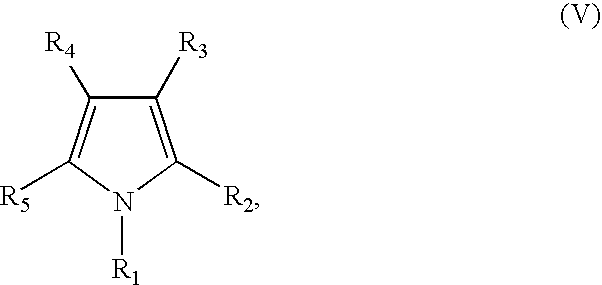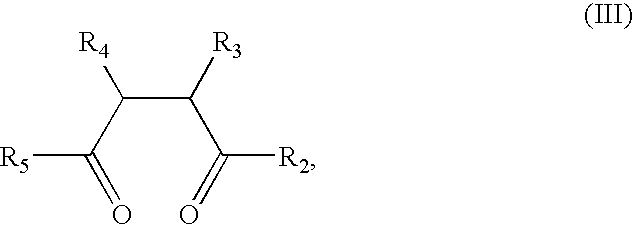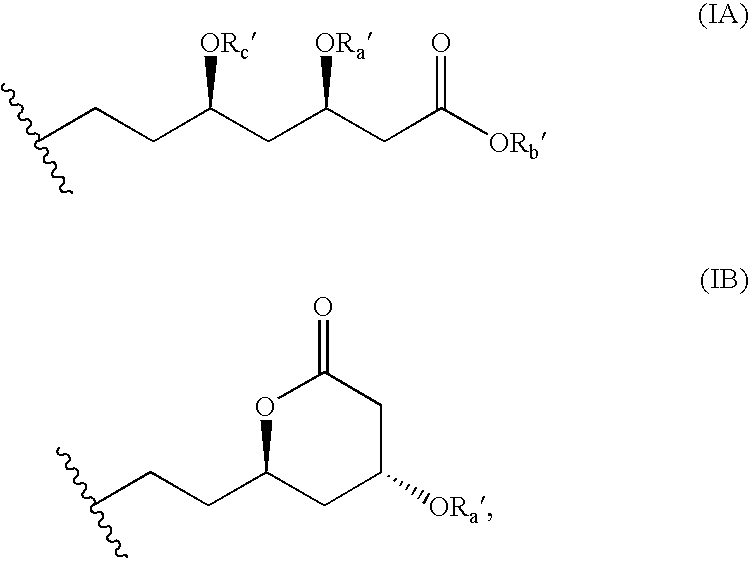Pyrrole synthesis
a pyrrole and pyrrole technology, applied in the field of pyrrole synthesis, can solve the problem of not being able to obtain n-substituted pyrroles in parts, and achieve the effect of high yield
- Summary
- Abstract
- Description
- Claims
- Application Information
AI Technical Summary
Benefits of technology
Problems solved by technology
Method used
Image
Examples
example 1
Preparation of an Atorvastatin Precursor
Substituents in the formulae: Rx=n-butyl (formula II*, IIa*), Rc′—Ra′=together isopropylidene, Rb′=ethyl (formula I*, IIa*, V*); R4=phenyl, R5=4-fluorophenyl (formula III*, V*); R6=2,4,6-trimethylphenyl (formula IV*).
The azide I*, 1.00 g (3.73 mmol), is dissolved at room temperature in 3 ml of dry toluene, and 0.92 ml (3.73 mmol) of tributylphosphine II* is added. On vigorous stirring, nitrogen begins to evolve. When the evolution of gas has ceased (and TLC monitoring) the mixture is added dropwise to a mixture of diketone III, 1.2 g (2.87 mmol) and 0.61 g (3.73 mmol) of 2,4,6-trimethylbenzoic acid IV* and molecular sieve 3A (Fluka, Buchs, Switzerland) in 6 ml of dry toluene at 60° C. When the reaction is complete (TLC monitoring), the mixture is extracted with 1N sodium hydroxide solution, 1N hydrochloric acid and saturated sodium chloride solution. The product is separated therefrom by column chromatography on silica gel (eluant CH...
example 2
Preparation of an Atorvastatin Precursor (Variant)
Substituents in the formulae:
Rc′—Ra′=together ethylidene, Rb′=ethyl (formula II*, IIa*, V*); Rx=n-butyl (formula II*, IIa*), R4=phenyl, R5=4-fluorophenyl (formula III*, V*); R6=2,4,6-triisopropylphenyl (formula IV*).
According to the process of Example 1, from 0.90 g of azide I* and 1.10 g of diketone III* in the presence of 0.87 g of tri-isopropylbenzoic acid there are obtained 1.08 g (68%) of pyrrole V having the substituents mentioned at the beginning.
1H-NMR (300 MHz) in CDCl3 (ppm): 1.12-1.40 m (8H); 1.54 dd (6H; 7.1 Hz, 7.1 Hz); 1.66-1.78 m (2H); 2.33 dd (1H; 6.2 Hz, 15.3 Hz); 2.54 dd (1H; 7.0 Hz; 15.3 Hz); 3.43 m (1H); 3.53 sept. (1H; 7.1 Hz); 3.96 m (2H); 3.96-4.15 m (3H); 4.52 q (1H, 7.1 Hz), 6.88-7.19 m (15H).
13C-NMR (75.4 MHz) in CDCl3 (ppm): 15.29; 21.96; 22.70; 22.98; 35.94; 38.60; 41.84; 61.59; 73.40; 73.80; 99.49; 116.17 d (JC,F 21.3 Hz); 116.53; 120.50; 122.82; 124.42; 127.49; 129.25; 129.56; 129.71; 131.41...
example 3
1-(n-Hexyl)-5-(4-fluorophenyl)-2-isopropyl-4-phenyl-3-phenylaminocarbonyl-pyrrole
Substituents in the formulae: Rx=n-butyl (formula II*, IIa*), R1=n-hexyl (formula I*, IIa*, V*); R4=phenyl, R5=4-fluorophenyl (formula III, V*); R6=2,4,6-triisopropylphenyl (formula IV*).
Analogously to the process of Example 1, from 0.46 g of azide I* and 1.35 g of diketone III* there is obtained 0.92 g (59%) of pyrrole V*, having the substituents mentioned at the beginning of this Example:
1H-NMR (300 MHz) in CDCl3 (ppm): 0.85 t (3H; 6.5 Hz); 1.13-1.24 m (6H); 1.54-1.60 m (8H); 3.55 sept. (1H; 7.3 Hz); 3.77-3.86 m (2H); 6.87-7.22 m (15H).
13C-NMR (75.4 MHz) in CDCl3 (ppm): 13.88; 21.71; 22.35; 26.26; 26.33; 31.04; 31.50; 44.66; 115.00 d (JC,F 21.3 Hz); 115.03; 119.37; 121.50; 123.25; 126.34; 128.13; 128.29 d (JC,F 8.1 Hz); 128.45; 128.68; 130.36; 133.02 d (JC,F 6.0 Hz); 134.60; 138.30; 141.20; 162.02 d (JC,F 247.3 Hz); 164.56; 170.79.
PUM
 Login to View More
Login to View More Abstract
Description
Claims
Application Information
 Login to View More
Login to View More - R&D
- Intellectual Property
- Life Sciences
- Materials
- Tech Scout
- Unparalleled Data Quality
- Higher Quality Content
- 60% Fewer Hallucinations
Browse by: Latest US Patents, China's latest patents, Technical Efficacy Thesaurus, Application Domain, Technology Topic, Popular Technical Reports.
© 2025 PatSnap. All rights reserved.Legal|Privacy policy|Modern Slavery Act Transparency Statement|Sitemap|About US| Contact US: help@patsnap.com



